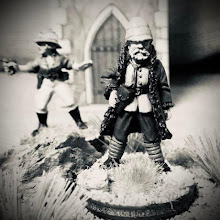Line up the arrow with the line on the card and move.
Recently I was challenged by Honorable Son #5 over the skies of World War I Europe. He was going to try out his new UFAG C.1, a two-seater reconnaissance plane escorted by an Albatross D.V.
The UFAG C.1 and the colorfully painted Albatross D.V.
The allies, played by yours truely, would have a Sopwith Camel and a Spad XIII.
The Sopwith is on the left and the Spad on the right
The UFAG C.1
The C.I served in the Imperial and Royal Aviation Troops in visual- and photographic reconnaissance, artillery observation and light bombing duties from early spring 1916 to the end of World War I. The aircraft had good handling characteristics, and steady introduction of more powerful engines in successive production batches (see below) enabled the improvement of performance and thus the continuing front-line service.
Armament of the type consisted of a free-firing 8 mm (.315 in) Schwarzlose machine gun at the rear for the observer, and at least in some aircraft for the pilot there was also a similar fixed, non-synchronised forward-firing gun in a pod above the top wing. This latter weapon was replaced in later production examples by a synchronised 8 mm (.315 in) Schwarzlose gun on the port side of the fuselage. The normal bomb load for the C.I was 60 kg (130 lb), but some aircraft could carry one 80 kg (180 lb) and two 10 kg (20 lb) bombs.
Albatross D.V.
Since it had been a while since we had played, our flying (especially mine) was less than spectacular as we started the game. The Sopwoth Camel and Spad XIII had several near collisions while the Albatros had difficulty staying near the action.
Another near miss!
The UFAG C.1 performed admirably, it's rear machine gun reminding the allied planes that it would be difficult to tail unless they got into the rear blindspot caused by the tail. The allies were being hammered as smoke and rudder malfunctions took a toll on their aircraft. Unfortunately for Honorable Son #5, a few stray bullets ignited a fire on the Albatros which resulted in a spectacular explosion. It was then only a matter of time as the two allied aircraft ganged up on the remain two-seater and the pilot of the Spad got his second kill of the day.
Yes, the Allies have another near collision!














I love this game too..it is good for all ages too, so ideal for dads and sons.
ReplyDeleteWhy not try some of the solo rules available online and play on the same side as your son?